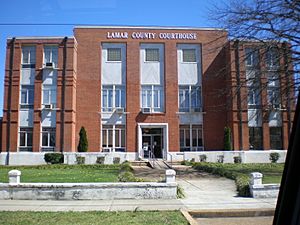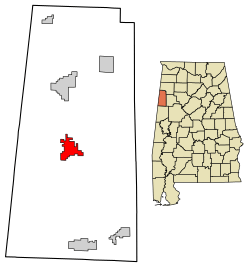Vernon, Alabama facts for kids
Quick facts for kids
Vernon
|
|
|---|---|

Lamar County courthouse in Vernon
|
|

Location of Vernon in Lamar County, Alabama.
|
|
| Country | United States |
| State | Alabama |
| County | Lamar |
| Area | |
| • Total | 5.89 sq mi (15.26 km2) |
| • Land | 5.89 sq mi (15.26 km2) |
| • Water | 0.00 sq mi (0.00 km2) |
| Elevation | 295 ft (90 m) |
| Population
(2020)
|
|
| • Total | 1,921 |
| • Density | 325.92/sq mi (125.85/km2) |
| Time zone | UTC-6 (Central (CST)) |
| • Summer (DST) | UTC-5 (CDT) |
| ZIP code |
35592
|
| Area code(s) | 205, 659 |
| FIPS code | 01-78480 |
| GNIS feature ID | 0153839 |
Vernon is a city in Lamar County, Alabama, USA. It is the main city, or county seat, of Lamar County. Vernon was also the county seat for earlier counties named Jones and Sanford before Lamar County was formed. The city officially became a town in 1870.
In 2010, about 2,000 people lived in Vernon. This was a bit less than the 2,143 people in 2000. Vernon is the biggest city in Lamar County as of 2010. It has held this title before, in 1880 and from 1960 to 1990.
Contents
Where is Vernon Located?
Vernon is located at 33°45′23″N 88°6′41″W / 33.75639°N 88.11139°W. This means it is at 33.756414 degrees North and -88.111409 degrees West.
The U.S. Census Bureau says the city covers about 5.9 square miles (15.26 square kilometers). All of this area is land.
What is the Weather Like in Vernon?
| Climate data for Vernon, Alabama, 1991–2020 normals, extremes 1956–present | |||||||||||||
|---|---|---|---|---|---|---|---|---|---|---|---|---|---|
| Month | Jan | Feb | Mar | Apr | May | Jun | Jul | Aug | Sep | Oct | Nov | Dec | Year |
| Record high °F (°C) | 82 (28) |
85 (29) |
89 (32) |
94 (34) |
100 (38) |
104 (40) |
105 (41) |
109 (43) |
104 (40) |
102 (39) |
89 (32) |
81 (27) |
109 (43) |
| Mean maximum °F (°C) | 71.6 (22.0) |
75.9 (24.4) |
82.0 (27.8) |
85.6 (29.8) |
91.0 (32.8) |
94.9 (34.9) |
97.8 (36.6) |
97.7 (36.5) |
94.8 (34.9) |
88.1 (31.2) |
79.6 (26.4) |
72.8 (22.7) |
99.2 (37.3) |
| Mean daily maximum °F (°C) | 55.0 (12.8) |
59.4 (15.2) |
68.0 (20.0) |
75.9 (24.4) |
82.7 (28.2) |
89.0 (31.7) |
91.8 (33.2) |
91.8 (33.2) |
86.7 (30.4) |
77.1 (25.1) |
65.6 (18.7) |
57.1 (13.9) |
75.0 (23.9) |
| Daily mean °F (°C) | 44.2 (6.8) |
48.1 (8.9) |
55.8 (13.2) |
62.9 (17.2) |
71.1 (21.7) |
78.2 (25.7) |
81.2 (27.3) |
80.9 (27.2) |
75.1 (23.9) |
64.2 (17.9) |
53.8 (12.1) |
46.6 (8.1) |
63.5 (17.5) |
| Mean daily minimum °F (°C) | 33.4 (0.8) |
36.9 (2.7) |
43.7 (6.5) |
49.9 (9.9) |
59.5 (15.3) |
67.5 (19.7) |
70.6 (21.4) |
69.9 (21.1) |
63.4 (17.4) |
51.2 (10.7) |
42.0 (5.6) |
36.0 (2.2) |
52.0 (11.1) |
| Mean minimum °F (°C) | 14.2 (−9.9) |
18.2 (−7.7) |
23.8 (−4.6) |
32.4 (0.2) |
42.8 (6.0) |
55.5 (13.1) |
62.0 (16.7) |
60.2 (15.7) |
48.2 (9.0) |
32.8 (0.4) |
23.2 (−4.9) |
19.1 (−7.2) |
11.9 (−11.2) |
| Record low °F (°C) | −11 (−24) |
1 (−17) |
6 (−14) |
20 (−7) |
30 (−1) |
38 (3) |
49 (9) |
46 (8) |
33 (1) |
21 (−6) |
9 (−13) |
−3 (−19) |
−11 (−24) |
| Average precipitation inches (mm) | 5.26 (134) |
4.94 (125) |
5.56 (141) |
5.94 (151) |
5.39 (137) |
4.72 (120) |
5.35 (136) |
3.49 (89) |
3.36 (85) |
3.82 (97) |
4.61 (117) |
6.01 (153) |
58.45 (1,485) |
| Average snowfall inches (cm) | 0.3 (0.76) |
0.0 (0.0) |
0.2 (0.51) |
0.0 (0.0) |
0.0 (0.0) |
0.0 (0.0) |
0.0 (0.0) |
0.0 (0.0) |
0.0 (0.0) |
0.0 (0.0) |
0.0 (0.0) |
0.0 (0.0) |
0.5 (1.27) |
| Average precipitation days (≥ 0.01 in) | 10.3 | 7.8 | 8.8 | 6.6 | 7.4 | 8.9 | 8.6 | 7.0 | 5.2 | 5.7 | 7.7 | 8.9 | 92.9 |
| Average snowy days (≥ 0.1 in) | 0.2 | 0.0 | 0.0 | 0.0 | 0.0 | 0.0 | 0.0 | 0.0 | 0.0 | 0.0 | 0.0 | 0.0 | 0.2 |
| Source 1: NOAA | |||||||||||||
| Source 2: National Weather Service | |||||||||||||
Vernon has a warm climate with hot summers. The average high temperature in July and August is around 91.8°F (33.2°C). Winters are mild, with an average high in January of 55.0°F (12.8°C).
The city gets a good amount of rain throughout the year. Snowfall is very rare in Vernon.
A Look at Vernon's History
Vernon was first called Swayne Courthouse. It was named after General Wager Swayne. He was a leader of the Freedman's Bureau in the area. Many old records were lost when the courthouse burned down in 1866.
In 1868, the town's name changed to Vernon. It was named after a person named Edmund Vernon.
Before and after the American Civil War, Vernon's economy relied on timber, farming, and milling. After the war, large farms were sold to timber companies. This caused many people to lose their jobs.
Since the time of Reconstruction, Vernon has had different types of factories. Textile factories, which make cloth, were common in the early 1900s. These factories are no longer open. However, some manufacturers are still in Vernon. For example, Marathon makes machines that compact trash.
Who Lives in Vernon?
| Historical population | |||
|---|---|---|---|
| Census | Pop. | %± | |
| 1880 | 208 | — | |
| 1890 | 192 | −7.7% | |
| 1900 | 291 | 51.6% | |
| 1910 | 423 | 45.4% | |
| 1920 | 440 | 4.0% | |
| 1930 | 519 | 18.0% | |
| 1940 | 759 | 46.2% | |
| 1950 | 791 | 4.2% | |
| 1960 | 1,492 | 88.6% | |
| 1970 | 2,190 | 46.8% | |
| 1980 | 2,609 | 19.1% | |
| 1990 | 2,247 | −13.9% | |
| 2000 | 2,143 | −4.6% | |
| 2010 | 2,000 | −6.7% | |
| 2020 | 1,921 | −3.9% | |
| U.S. Decennial Census 2013 Estimate |
|||
Vernon's Population in 2010
In 2010, there were 2,000 people living in Vernon. They lived in 890 homes, and 569 of these were families. The city had about 339 people per square mile (131 people per square kilometer).
Most of the people in Vernon were White (79.4%). About 18.1% were Black or African American. A small number were Native American (0.3%) or from two or more races (1.2%). About 1.7% of the people were Hispanic or Latino.
In 30.4% of homes, there were children under 18 years old. About 41.1% of homes had married couples. In 17.9% of homes, a woman was the head of the house without a husband. About 36.1% of homes were not families.
Around 33.4% of homes had only one person living there. About 14.2% of these single-person homes were people aged 65 or older. On average, there were 2.25 people per home and 2.86 people per family.
The average age of people in Vernon was 38.1 years old. About 26.3% of the population was under 18. Another 15.8% were 65 or older.
The average income for a household was $34,236. For families, the average income was $43,950. About 19.6% of all people and 15.9% of families lived below the poverty line. This included 22.2% of those under 18.
Vernon's Population in 2020
| Race | Num. | Perc. |
|---|---|---|
| White (non-Hispanic) | 1,503 | 78.24% |
| Black or African American (non-Hispanic) | 294 | 15.3% |
| Native American | 3 | 0.16% |
| Other/Mixed | 94 | 4.89% |
| Hispanic or Latino | 27 | 1.41% |
As of the 2020 United States census, 1,921 people lived in Vernon. There were 923 households and 535 families in the city.
Famous People from Vernon
- Reuben Houston "Rube" Burrow: He was a well-known outlaw in the late 1880s. He and his younger brother, James Buchanan "Jim" Burrow, robbed trains.
- Dixie McArthur: A former pitcher in Major League Baseball.
- Terry Moore: Born in Vernon, he was a major league baseball player.
- Guy Morton: Also born in Vernon, he was a major league baseball player.
- Dan Penn: A famous songwriter who was born in Vernon.
- William Hall Smith: He was the president of Mississippi State University from 1916 to 1920.
Images for kids
See also
 In Spanish: Vernon (Alabama) para niños
In Spanish: Vernon (Alabama) para niños


